一、弹性元素的增长因子属性 flex-grow
<!DOCTYPE html>
<html lang="en">
<head>
<meta charset="UTF-8">
<title>弹性元素的增长因子</title>
<link rel="stylesheet" type="text/css" href="static/css/style1.css">
</head>
<body>
<h2>1.默认flex-grow:0 不增长</h2>
<div class="container flex demo1">
<span class="item">item1</span>
<span class="item">item2</span>
<span class="item">item3</span>
</div>
<h2>2.flex-grow:1 增长</h2>
<div class="container flex demo2">
<span class="item">item1</span>
<span class="item">item2</span>
<span class="item">item3</span>
</div>
<h2>3.按增长因子比例分配给元素</h2>
<div class="container flex demo3">
<span class="item">item1</span>
<span class="item">item2</span>
<span class="item">item3</span>
</div>
<h2>4.小数增长因子,计算方法与整数相同</h2>
<!-- 增长因子只要大于一就是增长 -->
<div class="container flex demo4">
<span class="item">item1</span>
<span class="item">item2</span>
<span class="item">item3</span>
</div>
<h2>5.弹性元素不同宽度,计算方法相同</h2>
<!-- 增长因子只要大于一就是增长 -->
<div class="container flex demo5">
<span class="item">item1</span>
<span class="item">item2</span>
<span class="item">item3</span>
</div>
</body>
</html>
@import "public.css";
.container{
width: 400px;
}
.item{
width:100px;
}
.demo1>.item{
/*默认值,不要增长*/
flex-grow: 0;
}
/*-------------------------------*/
.demo2 > .item:first-of-type {
flex-grow: 0;
}
.demo2 > .item:nth-of-type(2) {
flex-grow: 0;
}
.demo2 > .item:last-of-type {
flex-grow: 1;
}
/*-------------------------------*/
.demo3 > .item:first-of-type {
flex-grow: 1;
}
.demo3 > .item:nth-of-type(2) {
flex-grow: 1;
}
.demo3 > .item:last-of-type {
flex-grow: 3;
}
/*-------------------------------*/
.demo4 > .item:first-of-type {
flex-grow: 0.6;
}
.demo4 > .item:nth-of-type(2) {
flex-grow: 0.7;
}
.demo4 > .item:last-of-type {
flex-grow: 0.9;
}
/*-------------------------------*/
.demo5 > .item:first-of-type {
width: 80px;
flex-grow: 0.6;
}
.demo5 > .item:nth-of-type(2) {
width: 80px;
flex-grow: 0.7;
}
.demo5 > .item:last-of-type {
width: 160px;
flex-grow: 0.9;
}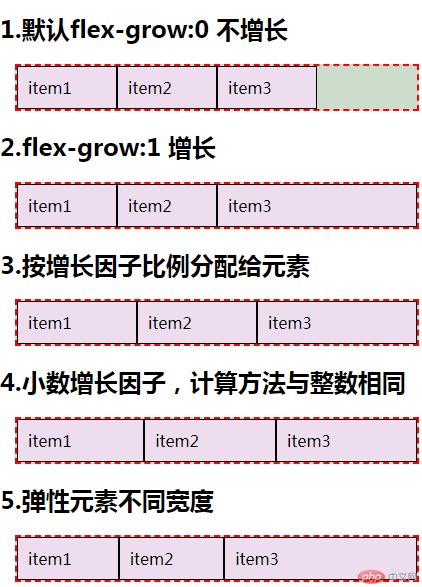
二、弹性元素的缩减因子属性 flex-shrink
<!DOCTYPE html>
<html lang="en">
<head>
<meta charset="UTF-8">
<title>弹性元素的缩减因子</title>
<link rel="stylesheet" type="text/css" href="static/css/style2.css">
</head>
<body>
<h2>1.默认状态允许缩减,flex-shrink:0设置不缩减</h2>
<div class="container flex demo1">
<span class="item">item1</span>
<span class="item">item2</span>
<span class="item">item3</span>
</div>
<h2>2.缩减因子flex-shrink: 1 默认</h2>
<div class="container flex demo2">
<span class="item">item1</span>
<span class="item">item2</span>
<span class="item">item3</span>
</div>
<h2>3.缩减因子不相等</h2>
<div class="container flex demo3">
<span class="item">item1</span>
<span class="item">item2</span>
<span class="item">item3</span>
</div>
<h2>4.缩减因子为小数</h2>
<div class="container flex demo4">
<span class="item">item1</span>
<span class="item">item2</span>
<span class="item">item3</span>
</div>
<h2>5.弹性元素宽度不同</h2>
<div class="container flex demo5">
<span class="item">item1</span>
<span class="item">item2</span>
<span class="item">item3</span>
</div>
</body>
</html>
@import "public.css";
.container{
width: 400px;
}
.item{
width: 150px;
}
.demo1>.item{
flex-shrink: 0;
}
/*--------------------------*/
.demo2>.item{
flex-shrink: 1;
}
/*--------------------------*/
.demo3>.item:first-of-type{
flex-shrink: 1;
}
.demo3>.item:nth-of-type(2){
flex-shrink: 2;
}
.demo3>.item:last-of-type{
flex-shrink: 3;
}
/*--------------------------*/
.demo4>.item:first-of-type{
flex-shrink: 0.5;
}
.demo4>.item:nth-of-type(2){
flex-shrink: 0.8;
}
.demo4>.item:last-of-type{
flex-shrink: 0.1;
}
/*--------------------------*/
.demo5>.item:first-of-type{
width: 300px;
flex-shrink: 1;
}
.demo5>.item:nth-of-type(2){
width: 100px;
flex-shrink: 1;
}
.demo5>.item:last-of-type{
width: 200px;
flex-shrink: 1;
}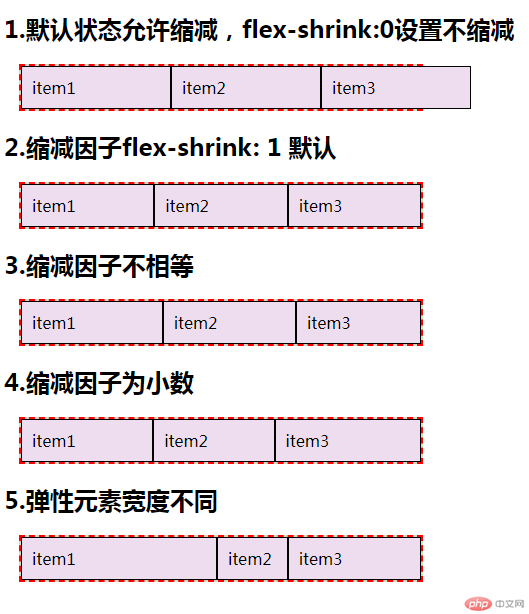
三、弹性元素的基准尺寸 flex-basis
<!DOCTYPE html>
<html lang="en">
<head>
<meta charset="UTF-8">
<title>弹性元素的基准尺寸</title>
<link rel="stylesheet" type="text/css" href="static/css/style3.css">
</head>
<body>
<h2>1.默认:未设置元素宽度时是内容宽度content</h2>
<div class="container flex demo1">
<span class="item">item1</span>
<span class="item">item2</span>
<span class="item">item3</span>
</div>
<h2>2.设置元素宽度显示为设置宽度</h2>
<div class="container flex demo2">
<span class="item">item1</span>
<span class="item">item2</span>
<span class="item">item3</span>
</div>
<h2>3.flex-basis: auto =content默认宽度</h2>
<div class="container flex demo3">
<span class="item">item1</span>
<span class="item">item2</span>
<span class="item">item3</span>
</div>
<h2>4.元素既有自定义宽度又有基准宽度,以基准宽度为准</h2>
<div class="container flex demo4">
<span class="item">item1</span>
<span class="item">item2</span>
<span class="item">item3</span>
</div>
<h2>5.元素基准尺寸支持百分比</h2>
<div class="container flex demo5">
<span class="item">item1</span>
<span class="item">item2</span>
<span class="item">item3</span>
</div>
</body>
</html>
@import "public.css";
.container{
width: 400px;
}
.demo1>.item{
flex-basis: content;
}
.demo2>.item{
width: 100px;
}
.demo3>.item{
flex-basis: auto;
}
.demo4>.item{
width: 100px;
flex-basis: 120px;
}
.demo5>.item:first-of-type{
flex-basis: 30%;
}
.demo5>.item:nth-of-type(2){
flex-basis: 40%;
}
.demo5>.item:last-of-type{
flex-basis: 30%;
}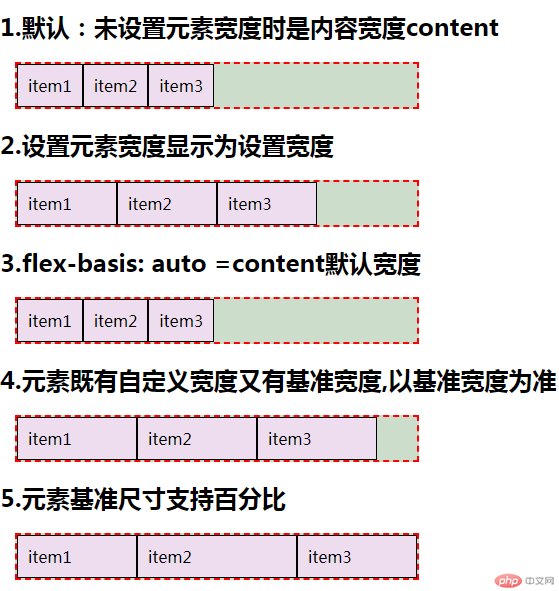
四、弹性元素属性的缩写 flex
格式:flex: 增长因子 缩减因子 基准因子
flex-grow flex-shrink flex-basis
<!DOCTYPE html>
<html lang="en">
<head>
<meta charset="UTF-8">
<title>弹性元素属性的缩写</title>
<link rel="stylesheet" type="text/css" href="static/css/style4.css">
</head>
<body>
<h2>1.默认初始 flex:0 1 auto=flex:inital</h2>
<div class="container flex demo1">
<span class="item">item1</span>
<span class="item">item2</span>
<span class="item">item3</span>
</div>
<h2>2.全适应 flex: 1 1 auto=flex:auto</h2>
<div class="container flex demo2">
<span class="item">item1</span>
<span class="item">item2</span>
<span class="item">item3</span>
</div>
<h2>3.失去弹性呈现原始大小 flex: 0 0 auto=flex:none</h2>
<div class="container flex demo3">
<span class="item">item1</span>
<span class="item">item2</span>
<span class="item">item3</span>
</div>
<h2>4.只有一个数值代表增长因子</h2>
<div class="container flex demo4">
<span class="item">item1</span>
<span class="item">item2</span>
<span class="item">item3</span>
</div>
<h2>5.三个数值 分别控制</h2>
<div class="container flex demo5">
<span class="item">item1</span>
<span class="item">item2</span>
<span class="item">item3</span>
</div>
<h2>6.谁设定可增长,剩余空间就会分配给它</h2>
<div class="container flex demo6">
<span class="item">item1</span>
<span class="item">item2</span>
<span class="item">item3</span>
</div>
</body>
</html>
@import "public.css";
.container{
width: 400px;
}
.demo1>.item{
width: 100px;
height: 60px;
flex: 0 1 auto;
/*不允许增长 允许缩小 基准尺寸为content*/
flex: initial;
}
.demo2>.item{
width: 100px;
height: 60px;
flex: 1 1 auto;
/*允许增长 允许缩小 基准尺寸为content*/
flex:auto;
}
.demo3>.item{
width: 120px;
height: 60px;
flex: 0 0 auto;
/*允许增长 允许缩小 基准尺寸为content*/
flex:none;
}
.demo5>.item{
width: 100px;
height: 60px;
flex: 1 1 200px;
}
.demo6>.item{
width: 100px;
height: 60px;
}
.demo6>.item:first-of-type{
flex:1 0 10px;
}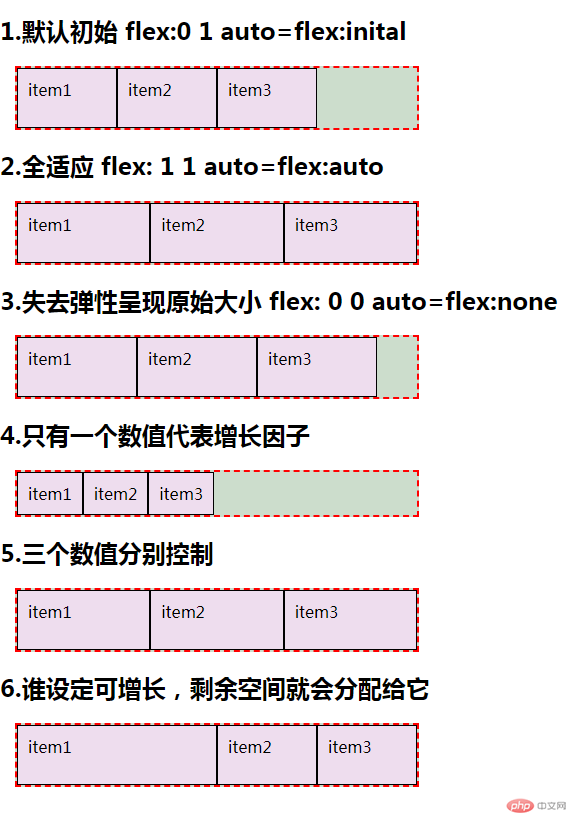
手抄flex的用法
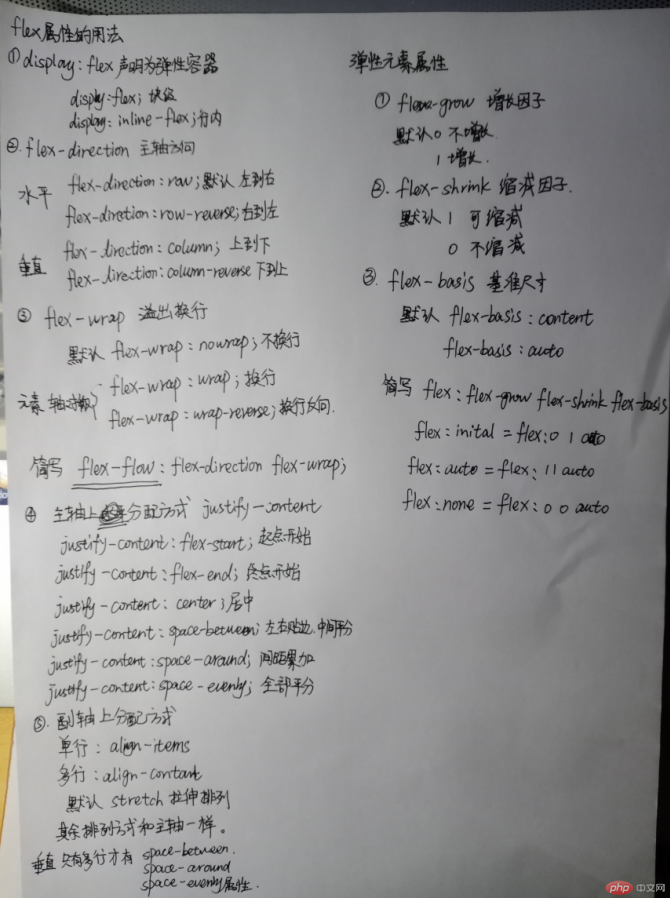
align-self, order的用法
align-self 单独定义弹性元素在侧轴上的对齐方式。
默认值 auto,继承父容器的align-item对齐方式,如果没有则为stretch。
可设置属性值 center:在侧轴居中、flex-start:在侧轴起点、flex-end:在侧轴终点。
order属性可以设定弹性元素在容器中的排列顺序,默认是按html文档书写的顺序进行排列。
设置order:数字(1,2,3,4....)可以调换他们的位置。
将圣杯布局改为弹性布局
<!DOCTYPE html>
<html lang="en">
<head>
<meta charset="UTF-8">
<title>圣杯布局flex模式</title>
<link rel="stylesheet" type="text/css" href="static/css/style6.css">
</head>
<body>
<header>头部</header>
<main>
<!-- 主题内容区优先渲染 -->
<article>主体</article>
<aside class="left">左</aside>
<aside class="right">右</aside>
</main>
<footer>底部</footer>
</body>
</html>
*{
margin: 0;
padding: 0;
}
body{
width: 1000px;
display: flex;
flex-flow: column nowrap;
}
header,footer{
box-sizing: border-box;
height: 50px;
background: lightgrey;
text-align: center;
}
main{
box-sizing: border-box;
flex: 1;
display: flex;
min-height: 600px;
}
aside{
box-sizing: border-box;
width: 200px;
}
article{
box-sizing: border-box;
flex: 1;
background-color: lightpink;
}
.left{
background-color: lightgreen;
order: -1;
}
.right{
background-color: lightblue;
}手抄代码
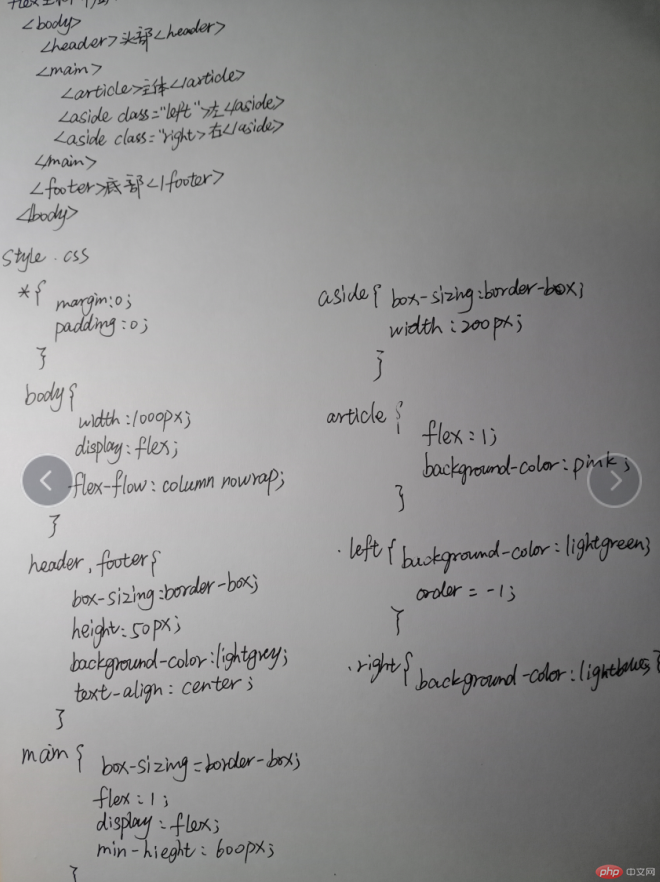
总结:理解了增长因子缩减因子按比例调整弹性元素的计算方法,还有元素不同大小下的计算方法。一些地方的属性控制是重叠的,设置一个就可以达到效果,其他属性会失去意义。简写方面还需对这些属性值更加了解熟悉。
Correction status:qualified
Teacher's comments:很认真, 加油
Statement of this Website
The copyright of this blog article belongs to the blogger. Please specify the address when reprinting! If there is any infringement or violation of the law, please contact admin@php.cn Report processing!

























![[Web front-end] Node.js quick start](https://img.php.cn/upload/course/000/000/067/662b5d34ba7c0227.png)









